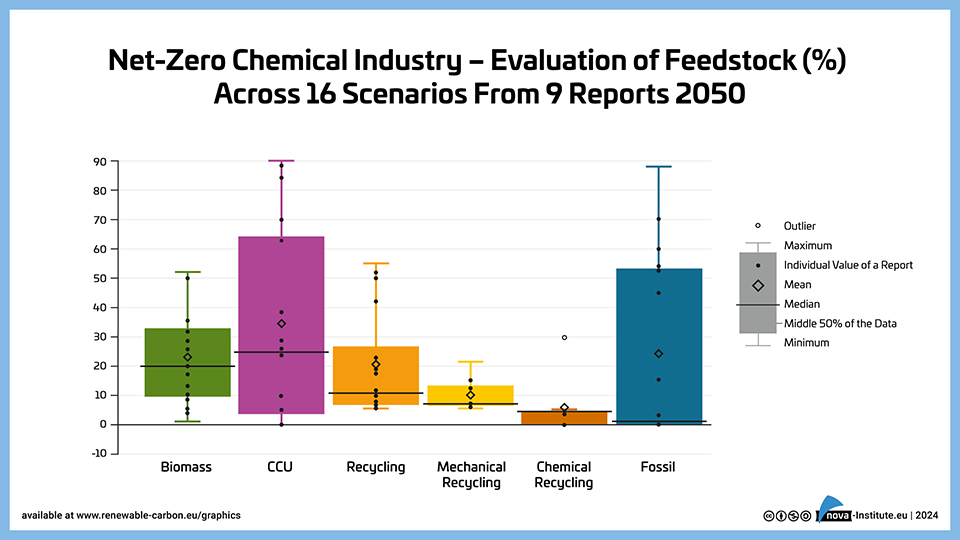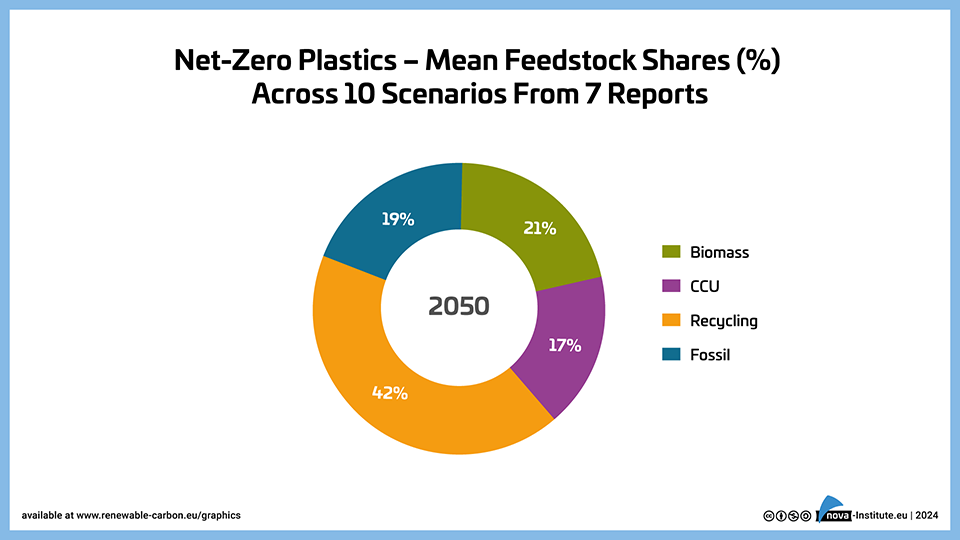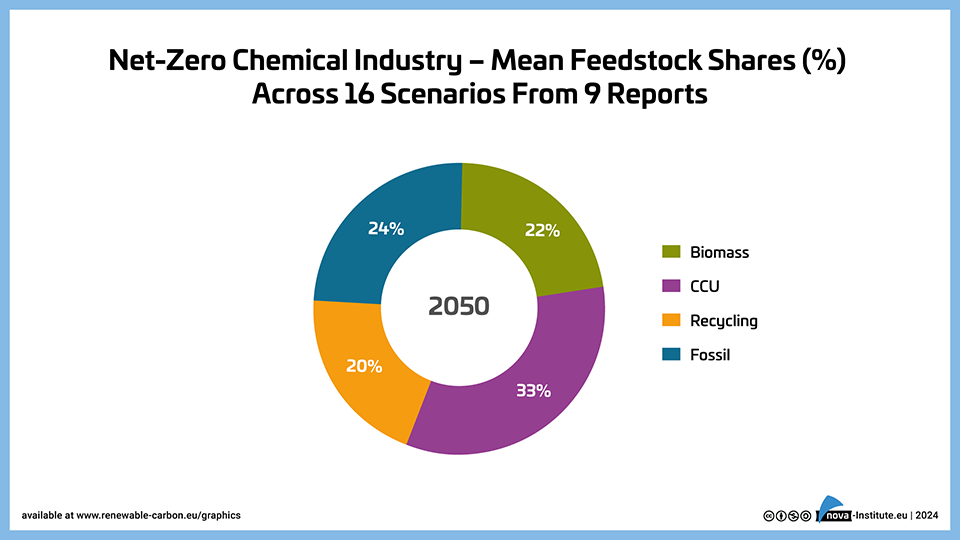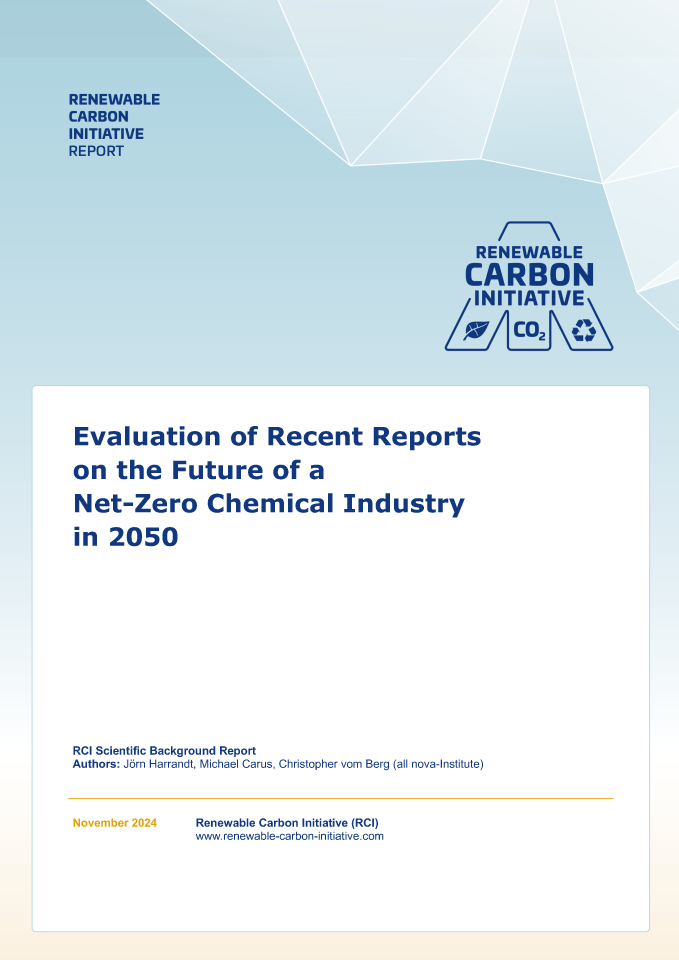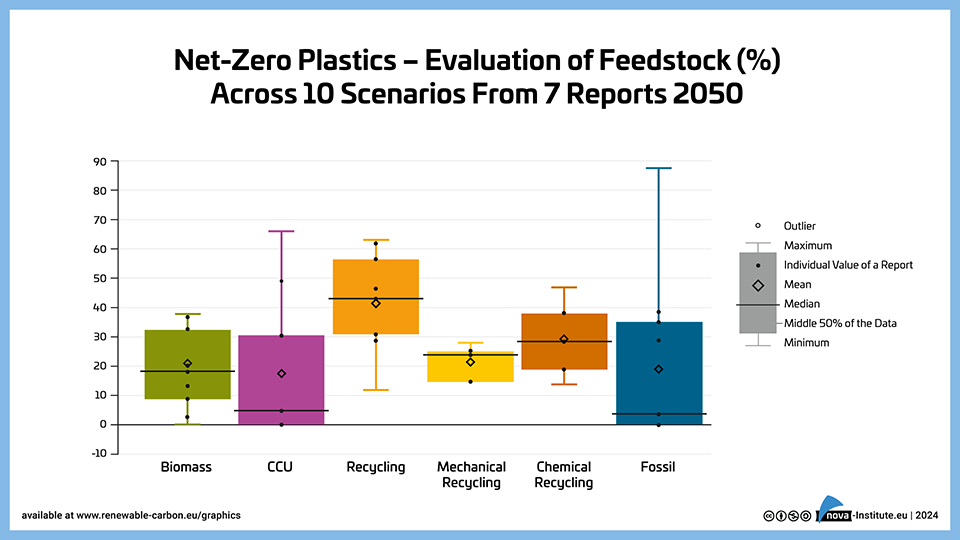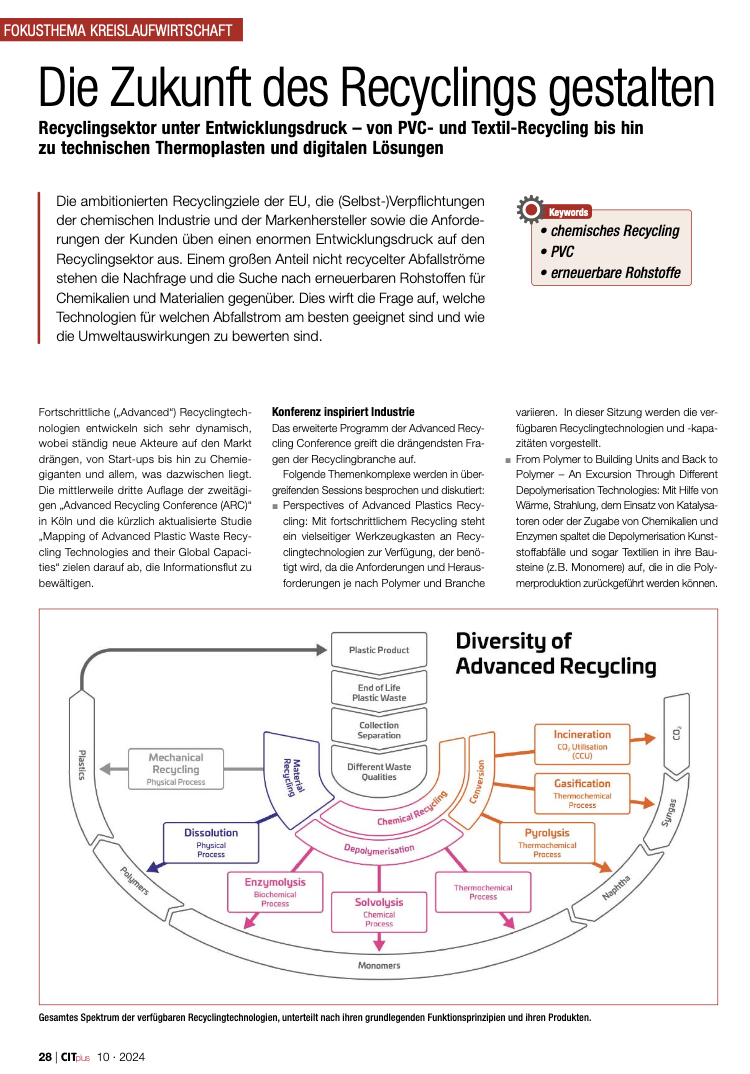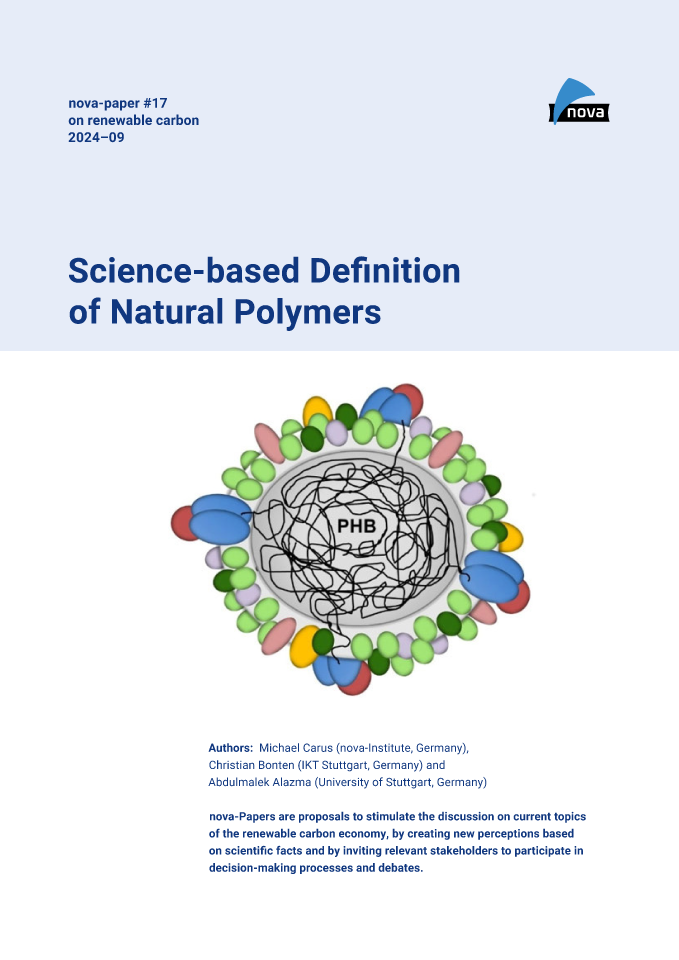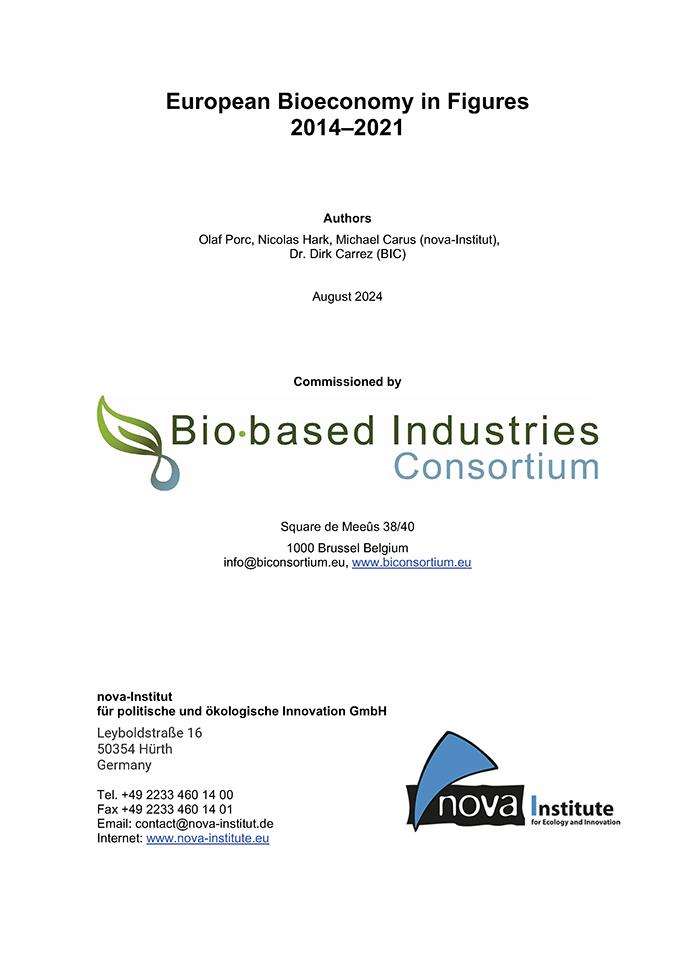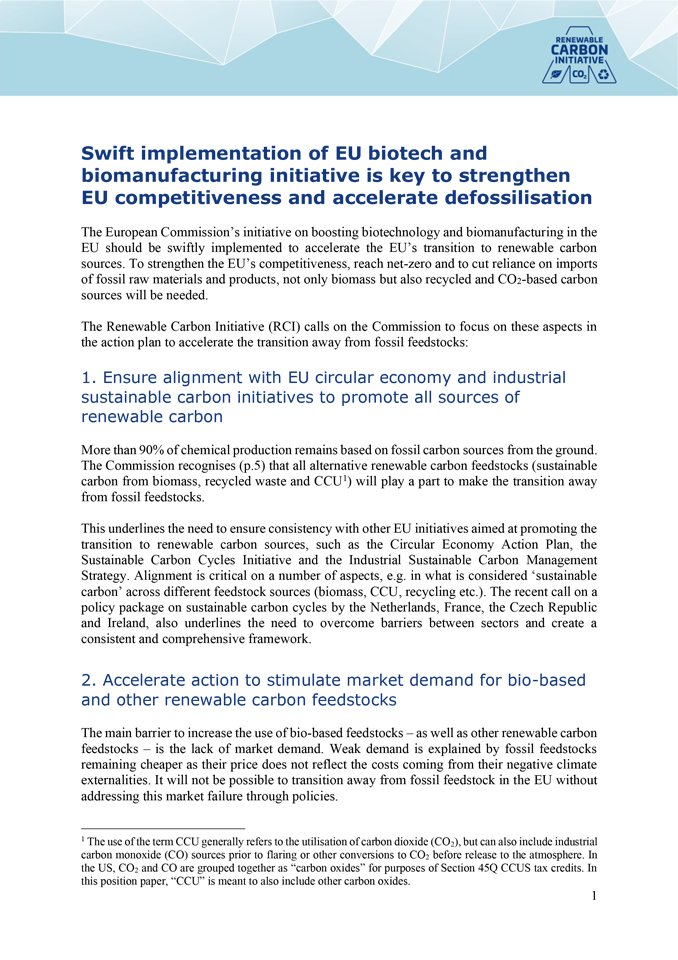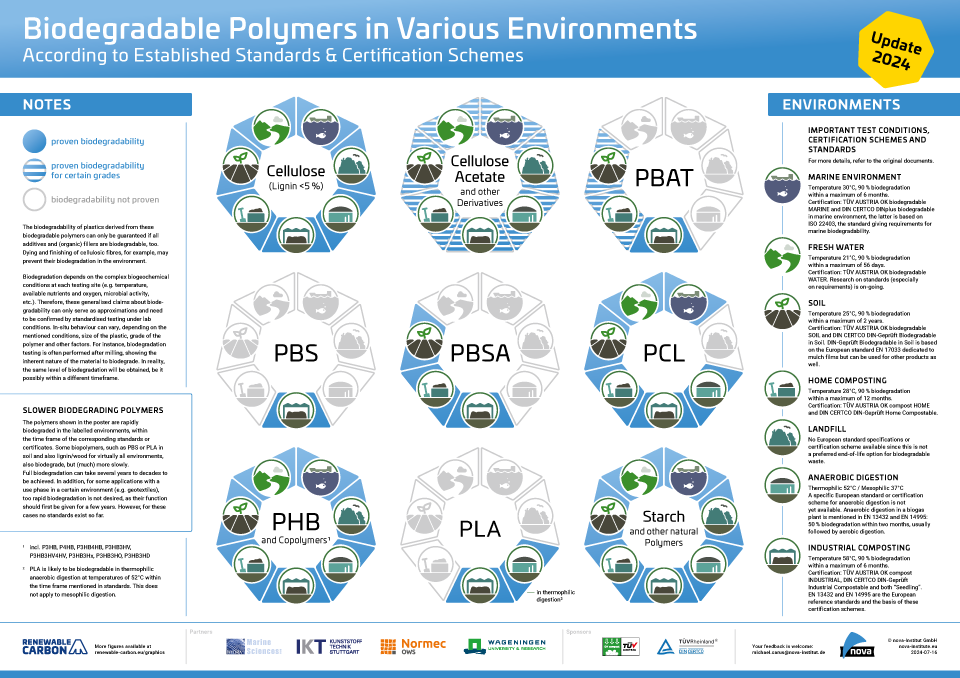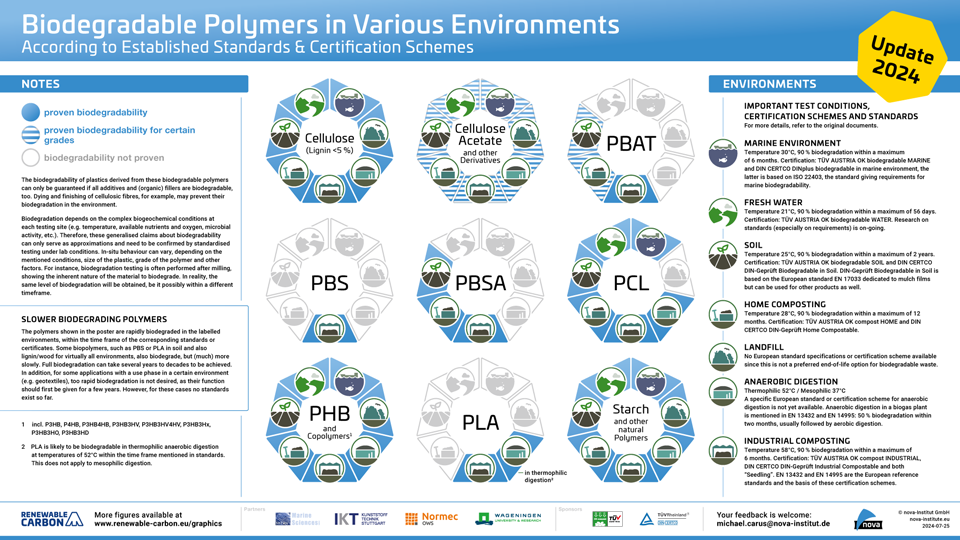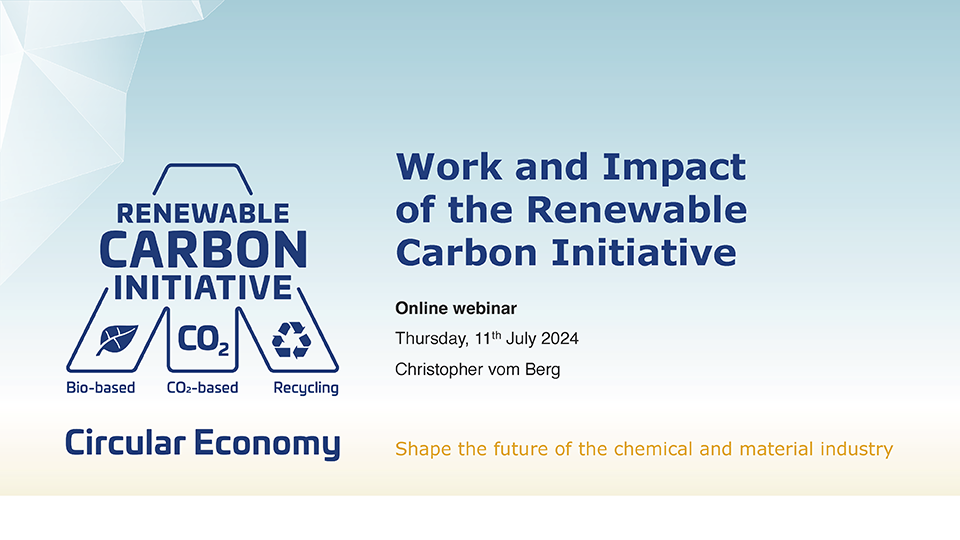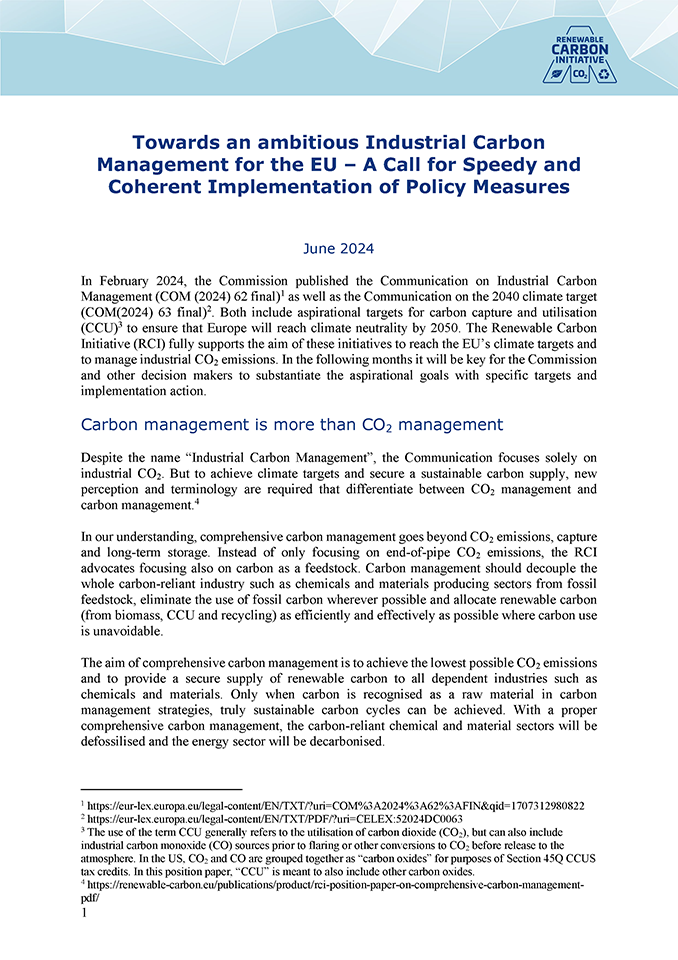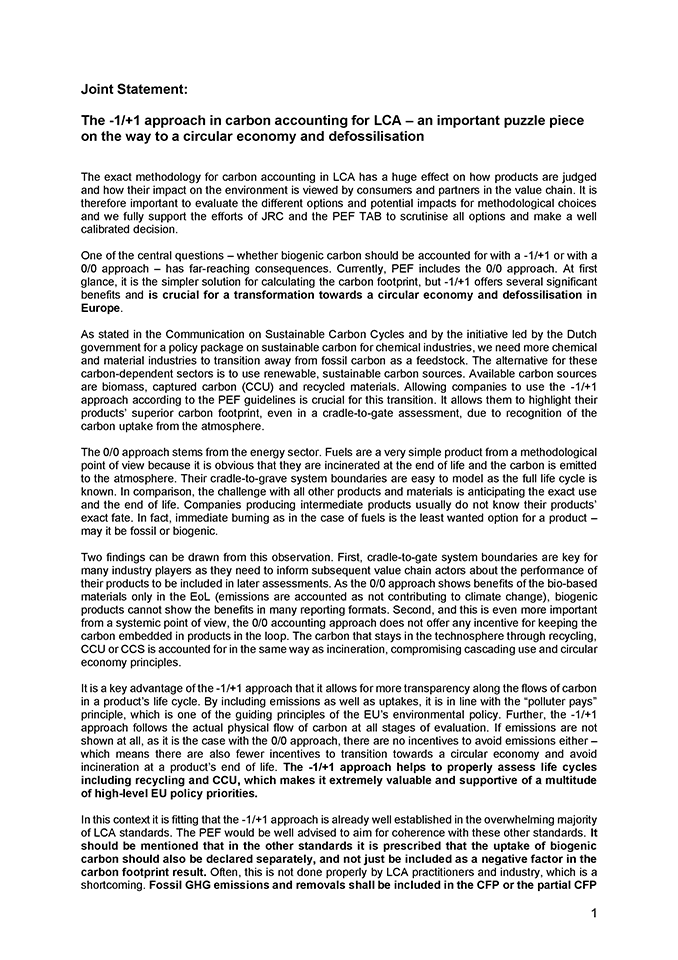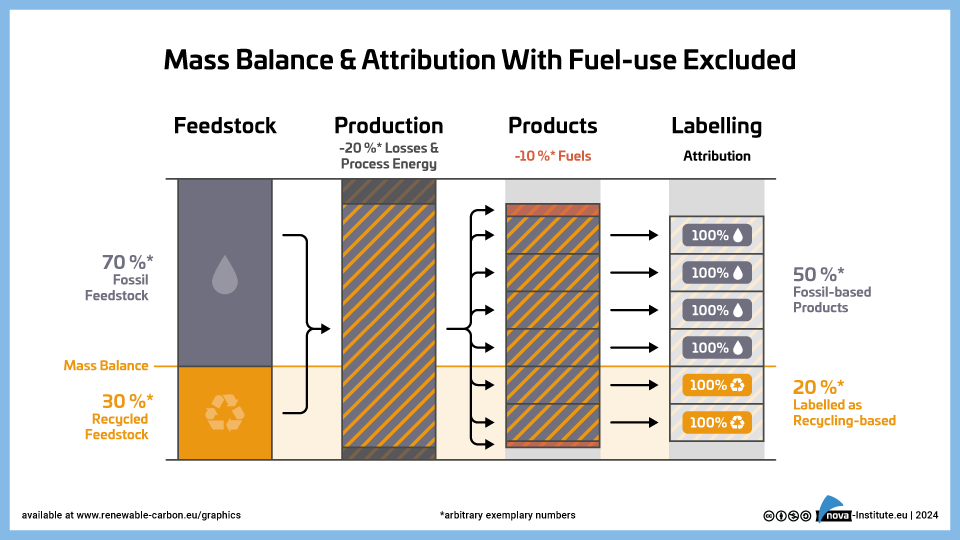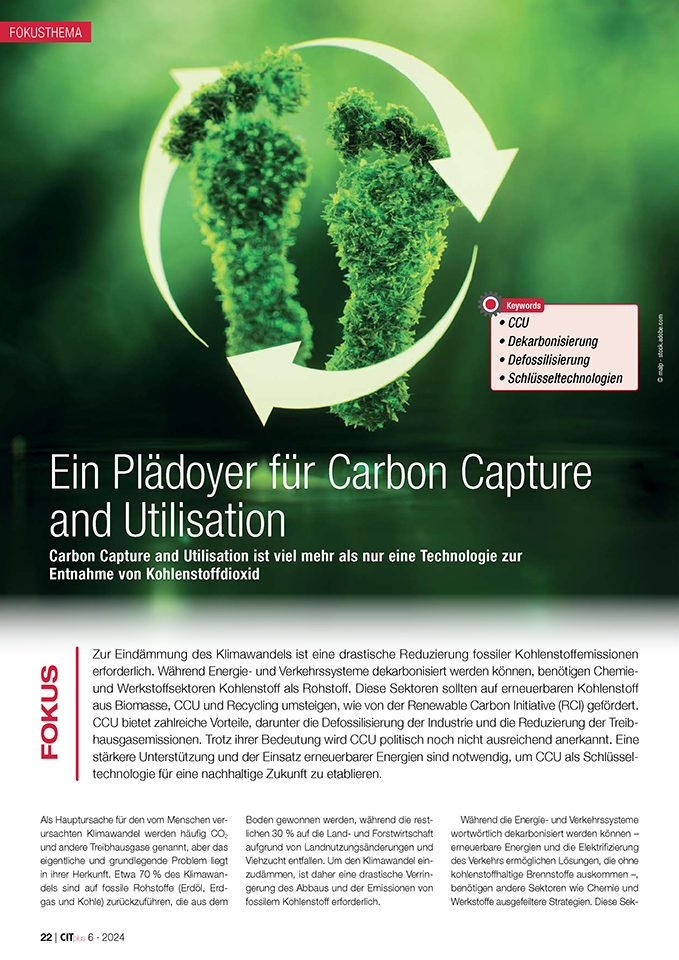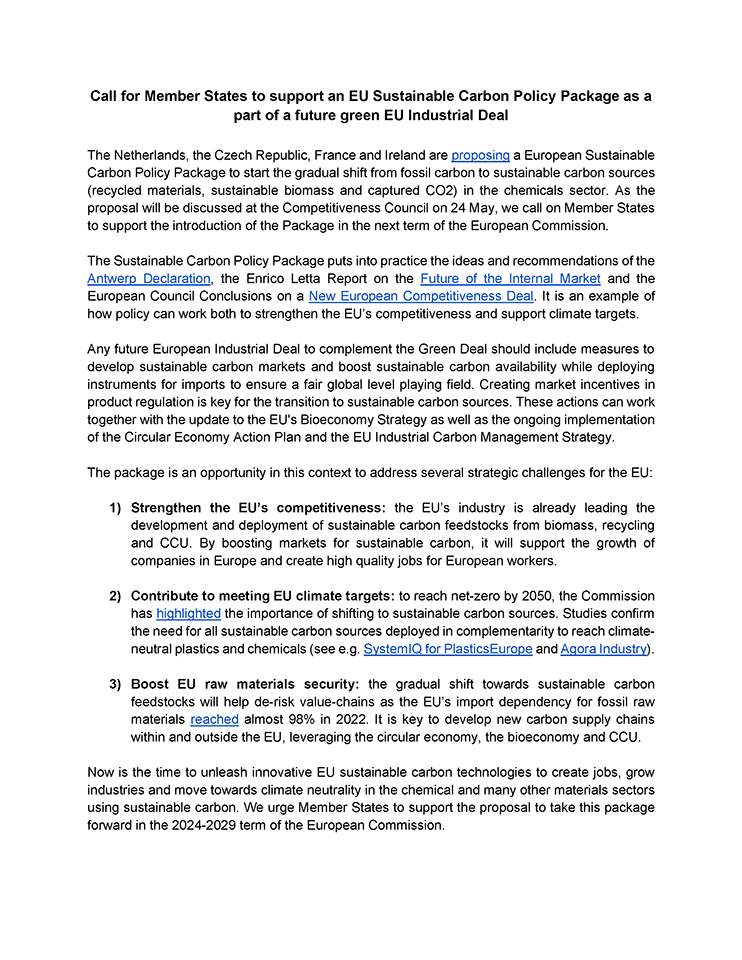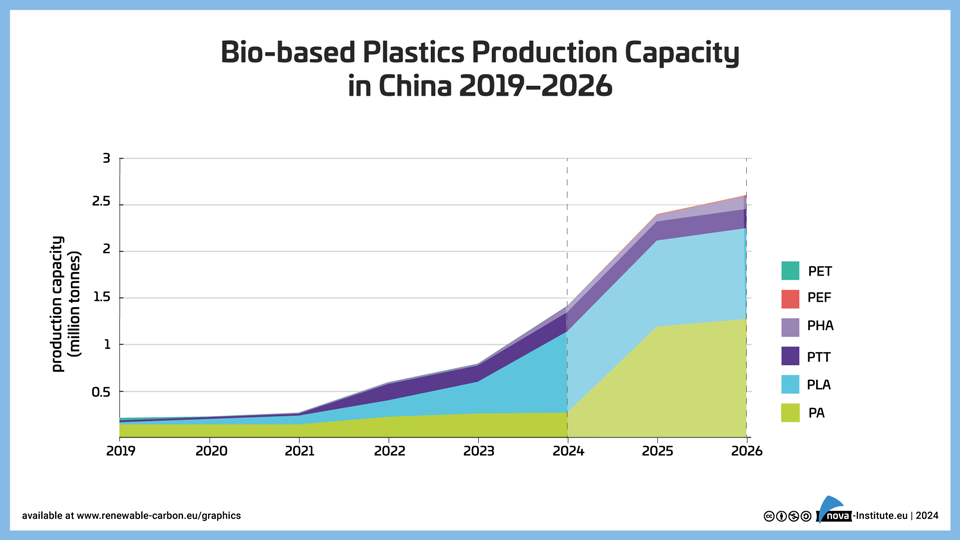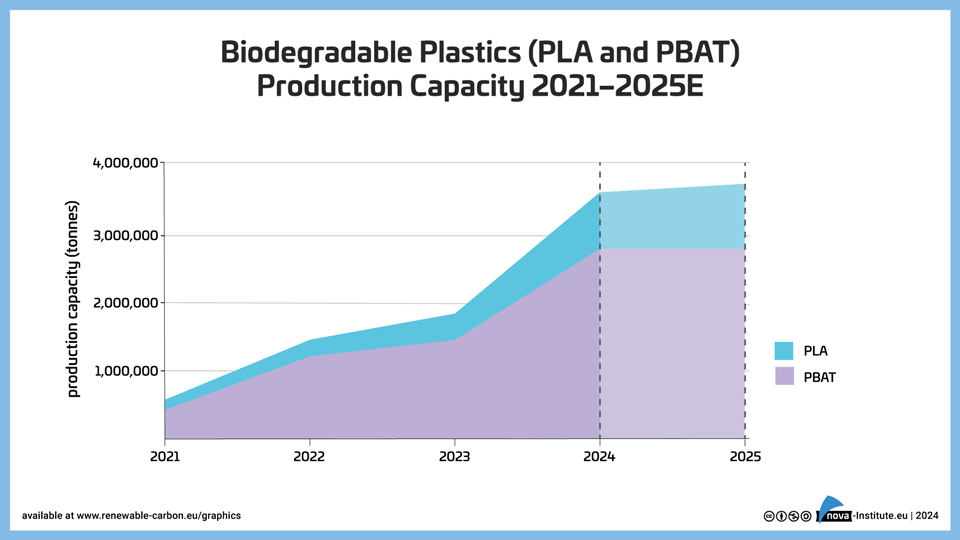Showing 41–60 of 218
-
Net-Zero Chemical Industry – Evaluation of Feedstock (%) Across 16 Scenarios from 9 Reports 2050 – Graphic (PNG)
Markets & Economy, Policy, Sustainability & Health
1 Page
74 Downloads
74 Downloads
2024-11
FREE
74
DownloadsThe graph shows the distribution of feedstock sources for the net-zero chemical industry by 2050, based on 16 scenarios from 9 reports, with CCU having the highest mean share at 33%, followed by biomass (22%), recycling (20%, split between mechanical and chemical), and fossil with CCS (24%). The data reveals significant variability across scenarios, particularly for CCU which ranges from near 0% to 90%, while both biomass and recycling show more moderate ranges, indicating a general consensus on their roles in the future chemical industry.
-
Net-Zero Plastics – Mean Feedstock Shares (%) Across 10 Scenarios From 7 Reports – Graphic (PNG)
Markets & Economy, Policy, Sustainability & Health
1 Page
61 Downloads
61 Downloads
2024-11
FREE
61
DownloadsThe graph presents the mean feedstock shares for the 2050 net-zero plastics sector, derived from 10 scenarios across 7 reports. In this projection, recycling dominates with a 42% share, followed by biomass (21%), fossil & CCS (19%), and CCU (17%), highlighting the increased potential for circularity in the plastics industry compared to the broader chemical sector.
-
Net-Zero Chemical Industry – Mean Feedstock Shares (%) Across 16 Scenarios From 9 Reports – Graphic (PNG)
Markets & Economy, Policy, Sustainability & Health
1 Page
47 Downloads
47 Downloads
2024-11
FREE
47
DownloadsThe graph illustrates the mean feedstock shares projected for the 2050 net-zero chemical industry, based on 16 scenarios across 9 reports. The chart shows a diverse mix of feedstocks, with CCU (33%) and recycling (20%) playing significant roles alongside biomass (22%), while fossil & CCS still account for 24% of the feedstock share.
-
Evaluation of Recent Reports on the Future of a Net-Zero Chemical Industry in 2050 (PDF)
Markets & Economy, Policy, Sustainability & Health
20 Pages
1408 Downloads
1408 Downloads
2024-11
FREE
Free Shipping1408
DownloadsThe Renewable Carbon Initiative’s Scientific Background Report assesses 24 scenarios from 15 studies to envision a net-zero chemical industry by 2050. The analysis anticipates continued growth in chemical production, projecting a 2.4-fold increase in global feedstock demand by 2050 compared to 2020 levels, with most expansion expected outside Europe while European feedstock volumes remain stable. To achieve net-zero emissions, the industry is projected to undergo a significant shift in feedstocks, with key renewable carbon sources identified as biomass (22%), carbon capture and utilisation (33%), and recycling (20%), while the remaining 24% comes from fossil sources with carbon capture and storage. For plastics specifically, recycling is expected to play an even larger role, accounting for 42% of feedstocks on average. This transition will require continued innovation and investment in renewable carbon technologies to meet ambitious defossilisation goals.
The report provides invaluable insights for industry leaders, policymakers, and researchers, highlighting the urgent need for action to achieve a net-zero future in the chemical sector by 2050.
DOI No.: https://doi.org/10.52548/SXWV6083
-
Net-Zero Plastics – Evaluation of Feedstock (%) Across 10 Scenarios from 7 Reports 2050 – Graphic (PNG)
Markets & Economy, Policy, Sustainability & Health
1 Page
95 Downloads
95 Downloads
2024-11
FREE
95
DownloadsThe graph illustrates feedstock projections specifically for the plastics sector by 2050, analysing 10 scenarios from 7 reports, where recycling emerges as the dominant feedstock at 42% (combining mechanical and chemical recycling), while biomass (21%), CCU (17%), and fossil with CCS (19%) play supporting roles. The data shows less variation in projections compared to the chemical industry overall, suggesting stronger agreement on the future role of recycling in plastics production.
-
Die Zukunft des Recyclings gestalten (PDF)
Markets & Economy, Policy, Sustainability & Health, Technology
2 Pages
406 Downloads
406 Downloads
2024-10
FREE
Free Shipping406
DownloadsDie ambitionierten Recyclingziele der EU, die (Selbst-)Verpflichtungen der chemischen Industrie und der Markenhersteller sowie die Anforderungen der Kunden üben einen enormen Entwicklungsdruck auf den Recyclingsektor aus. Einem großen Anteil nicht recycelter Abfallströme stehen die Nachfrage und die Suche nach erneuerbaren Rohstoffen für Chemikalien und Materialien gegenüber. Dies wirft die Frage auf, welche Technologien für welchen Abfallstrom am besten geeignet sind und wie die Umweltauswirkungen zu bewerten sind.
-
nova-paper #17: Science-based Definition of Natural Polymers (PDF)
NewMarkets & Economy, Policy, Sustainability & Health
22 Pages
642 Downloads
642 Downloads
2024-09
FREE
Free Shipping642
DownloadsEuropean policy has defined „natural polymers“ in a way that has caused much concern and debate among scientists and industry, and has created a barrier to innovation. The authors of this report have carried out a comprehensive scientific evaluation of how the scientific literature defines „natural polymers“, and the result is: The European policy definition is partly in clear contrast to the scientific definitions.
„Occurring in nature“ is the basis for every definition of „natural polymers“ in the scientific literature and in policy. All scientific definitions include biotechnological processes for the production of natural polymers. Not a single definition mentions the place of polymerisation as a criterion – in clear contrast to European policy. Industrial practice confirms this finding: A long list of widely accepted natural polymers includes biotechnologically processed polymers and the place of polymerisation is not a criterion.
Conclusion: A policy definition of „natural polymers“ that is at odds with almost all scientific definitions and at odds with business reality, and which is a major barrier to innovation, green investment and lower carbon footprints, needs to be revised.
The essence of the scientific definitions evaluated in this report is simple and leads to the following proposed definition: „Natural polymers are those that occur in nature, are produced in and extracted from nature, or can be produced identically using biotechnological processes“.DOI No.: https://doi.org/10.52548/UGBZ5516
-
European Bioeconomy in Figures 2014–2021 (PDF)
Markets & Economy, Policy, Sustainability & Health
29 Pages
739 Downloads
739 Downloads
2024-09
FREE
Free Shipping739
DownloadsThe bioeconomy in the European Union is a strong contributor to the overall economy and accounts for over 16 million employees and more than 2.3 trillion Euro in turnover across all 27 Member States. In terms of turnover almost half of the 2.3 trillion Euro can be attributed to the food and feed industries, which remain a large part of the EU bioeconomy. Adding to this are the agriculture and forestry sectors providing primary biomass to bioeconomic processes. However, the sectors processing these feedstocks and manufacturing intermediate and end-use products, collectively referred to as the bio-based industries, find themselves contributing on a stable level to the overall bioeconomy and account for almost a third of the overall turnover.
-
Swift implementation of EU biotech and biomanufacturing initiative is key to strengthen EU competitiveness and accelerate defossilisation (PDF)
Markets & Economy, Policy, Sustainability & Health
3 Pages
410 Downloads
410 Downloads
2024-09
FREE
Free Shipping410
DownloadsThe Renewable Carbon Initiative’s position paper emphasizes that the EU must swiftly implement its biotechnology and biomanufacturing initiative to accelerate the shift from fossil carbon to renewable sources and boost competitiveness. The Renewable Carbon Initiative (RCI) highlights three key actions:
1.) Align with Circular Economy Policies: Ensure consistency across EU initiatives to promote renewable carbon from biomass, recycling, and CCU.
2.) Boost Market Demand: Address the lack of demand for renewable feedstocks by implementing policies to make fossil alternatives less competitive.
3.) Enable Fossil-to-Renewable Transition: Repurposing current fossil-based manufacturing to use renewable feedstocks. Clear sustainability criteria, access to various biomass sources, and broader definitions of biomanufacturing processes are essential to achieving this transition.
These actions are vital for achieving net-zero goals and strengthening EU industry.
-
Biodegradable Polymers in Various Environments According to Established Standards and Certification Schemes – Graphic (PDF, current version)
Sustainability & Health
1 Page
1337 Downloads
1337 Downloads
2024-08
FREE
1337
DownloadsThird update of the well-known poster showing biodegradable polymers in different environments according to established standards and certification schemes.
The expert group met again this year to discuss the latest scientific evidence in the field of biodegradable polymers in order to make meaningful changes to the poster. The generic classification on the poster is only supported by tests performed in the context of certification. Therefore, the expert group decided to include the biodegradability of polycaprolactone (PCL) in additional environments: soil, freshwater, marine and anaerobic conditions. In addition, a new certification for marine biodegradability has been published by DIN CERTCO in 2023, based on ISO 22403, the standard that provides requirements for marine biodegradability, and is now mentioned on the poster. A new poster design and a more precise definition of biodegradation and biodegradability complete the update for this year.
-
Biodegradable Polymers in Various Environments According to Established Standards and Certification Schemes – Graphic (PNG, current version)
Sustainability & Health
1 Page
561 Downloads
561 Downloads
2024-08
FREE
561
DownloadsThird update of the well-known poster showing biodegradable polymers in different environments according to established standards and certification schemes.
The expert group met again this year to discuss the latest scientific evidence in the field of biodegradable polymers in order to make meaningful changes to the poster. The generic classification on the poster is only supported by tests performed in the context of certification. Therefore, the expert group decided to include the biodegradability of polycaprolactone (PCL) in additional environments: soil, freshwater, marine and anaerobic conditions. In addition, a new certification for marine biodegradability has been published by DIN CERTCO in 2023, based on ISO 22403, the standard that provides requirements for marine biodegradability, and is now mentioned on the poster. A new poster design and a more precise definition of biodegradation and biodegradability complete the update for this year.
-
Renewable Carbon Initiative (RCI) Webinar slides – July 2024 (PDF)
Policy, Sustainability & Health, Technology
60 Pages
477 Downloads
477 Downloads
2024-07
FREE
Free Shipping477
DownloadsThis document contains a generic set of slides to introduce the concept of renewable carbon and the Renewable Carbon Initiative. The focus of this webinar is the work and impact of the RCI. Moreover, Arndt Scheidgen, Head of Product Stewardship at Henkel Consumer Brands joined the webinar to give insights as an industry leader.
-
Towards an ambitious Industrial Carbon Management for the EU – A Call for Speedy and Coherent Implementation of Policy Measures (PDF)
Markets & Economy, Policy, Sustainability & Health
3 Pages
478 Downloads
478 Downloads
2024-07
FREE
478
DownloadsThe Renewable Carbon Initiative’s position paper emphasizes the need for a comprehensive industrial carbon management strategy in the EU that goes beyond CO2 emissions to include all carbon sources, promoting the use of renewable carbon from biomass, CCU, and recycling. It calls for the establishment of a regulatory framework with specific sub-targets and incentives by 2025 to accelerate the adoption of circular carbon technologies and reduce dependence on fossil feedstocks. The paper argues that recognising carbon as a raw material is essential for achieving sustainable carbon cycles and meeting the EU’s climate neutrality goals by 2050.
-
Joint Statement PEF TAB – biogenic carbon modelling (PDF)
Markets & Economy, Policy, Sustainability & Health
4 Pages
461 Downloads
461 Downloads
2024-06
FREE
461
DownloadsThe RCI along with the organisations APAG Oleochemicals Europe, Bio-based Industries Consortium, BioChem Europe, EuropaBio, GO!PHA, IKT Kunststofftechnik Stuttgart and Plastics Europe submitted this Joint Statement to the members of the Technical Advisory Boyard of the Product Environmental Footprint (PEF TAB). The purpose of this submission is to address the ongoing discussions on carbon modelling in the EF, which have been frequently discussed in recent PEF TAB meetings. With this joint statement we advocate for enabling -1/+1 accounting of biogenic and atmospheric carbon in the LCA methodology.
-
Renewable Materials Conference 2024 (Proceedings, PDF)
Markets & Economy, Policy, Sustainability & Health, Technology

2024-06
200 € ex. tax
Plus 19% MwSt.Press
release Add to
cartThe proceedings of the Renewable Materials Conference 2024 (11-13 June 2024, https://renewable-materials.eu) contain all released presentations, the conference journal, and the press release of the three winners of the Innovation Award “Renewable Material of the Year 2024″.
-
Mass Balance & Attribution With Fuel-use Excluded (PNG)
Markets & Economy, Policy, Sustainability & Health, Technology
1 Page
233 Downloads
233 Downloads
2024-06
FREE
233
DownloadsThe graphic shows the approach of mass balance and attribution with fuel-use excluded which allows to track the fossil and recycled share of feedstock. The recycled content can be attributed to products after deducting lossess and proess energy during production and, if applicable, produced energy carriers (fuel-use excluded). This approach ensures that a transparent amount of fossil feedstock is replaced by recycled feedstock in the production process and that only recycled feedstock that actually ends up in products can be attributed.
-
Ein Plädoyer für Carbon Capture and Utilisation – Carbon Capture and Utilisation ist viel mehr als nur eine Technologie zur Entnahme von Kohlenstoffdioxid (PDF)
Markets & Economy, Policy, Sustainability & Health
4 Pages
389 Downloads
389 Downloads
2024-06
FREE
389
DownloadsZur Eindämmung des Klimawandels ist eine drastische Reduzierung fossiler Kohlenstoffemissionen erforderlich. Während Energie- und Verkehrssysteme dekarbonisiert werden können, benötigen Chemie- und Werkstoffsektoren Kohlenstoff als Rohstoff. Diese Sektoren sollten auf erneuerbaren Kohlenstoff aus Biomasse, CCU und Recycling umsteigen, wie von der Renewable Carbon Initiative (RCI) gefördert.
CCU bietet zahlreiche Vorteile, darunter die Defossilisierung der Industrie und die Reduzierung der Treibhausgasemissionen.
Trotz ihrer Bedeutung wird CCU politisch noch nicht ausreichend anerkannt. Eine stärkere Unterstützung und der Einsatz erneuerbarer Energien sind notwendig, um CCU als Schlüssel- technologie für eine nachhaltige Zukunft zu etablieren.
Weitere Informationen:
https://www.chemanager-online.com/news/ein-plaedoyer-fuer-carbon-capture-and-utilisation
-
Call for Member States to support an EU Sustainable Carbon Policy Package as a part of a future green EU Industrial Deal (PDF)
Markets & Economy, Policy, Sustainability & Health
2 Pages
412 Downloads
412 Downloads
2024-05
FREE
Free Shipping412
DownloadsThe signatories of this proposal urge Member States to support the EU Sustainable Carbon Policy Package for the 2024-2029 term of the European Commission.
The Netherlands, the Czech Republic, France, and Ireland are advocating for an EU Sustainable Carbon Policy Package to transition the chemicals sector from fossil carbon to sustainable sources. This proposal, to be discussed at the Competitiveness Council on May 24, aims to enhance EU competitiveness, achieve climate targets, and secure raw material supplies by developing sustainable carbon markets and promoting innovative technologies. The initiative aligns with the Antwerp Declaration, the Enrico Letta Report, and the European Council Conclusions, and seeks to support job creation, industry growth, and climate neutrality.
-
Bioplastics Production Capacity in China 2019–2026 – Graphic (PNG)
Markets & Economy, Policy, Sustainability & Health
1 Page
29 Downloads
29 Downloads
2024-05
FREE
29
Downloads -
Biodegradable Plastics PLA and PBAT Production Capacity 2021-2025 – Graphic (PNG)
Markets & Economy, Policy, Sustainability & Health
1 Page
27 Downloads
27 Downloads
2024-05
FREE
27
Downloads

 Renewable Materials Conference 2024 (Proceedings, PDF) [Digital]
Renewable Materials Conference 2024 (Proceedings, PDF) [Digital] 